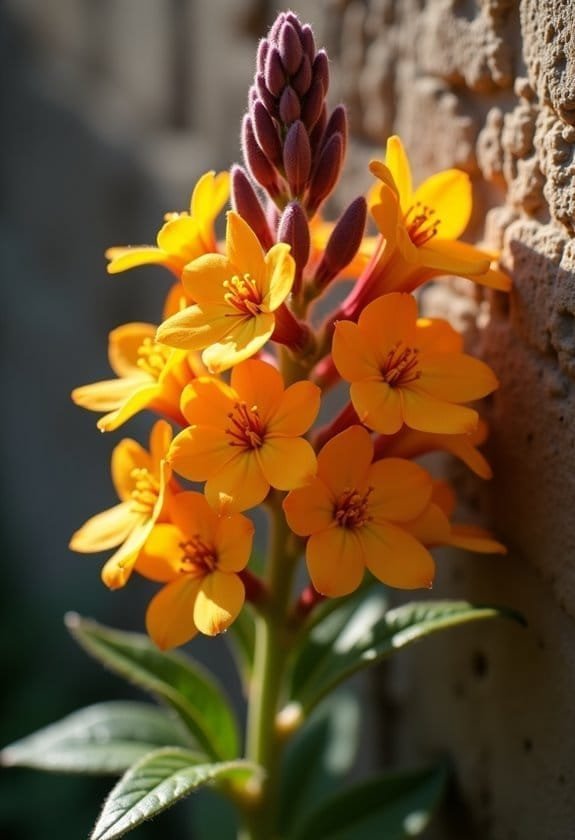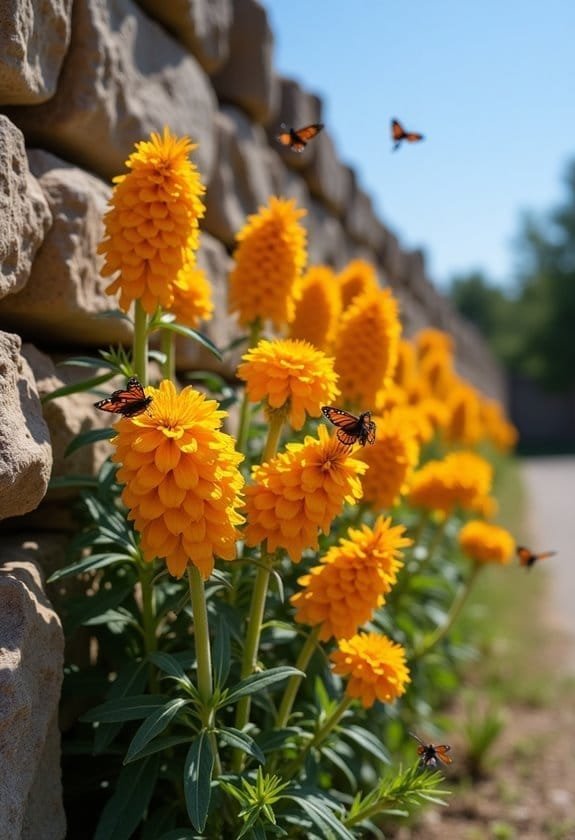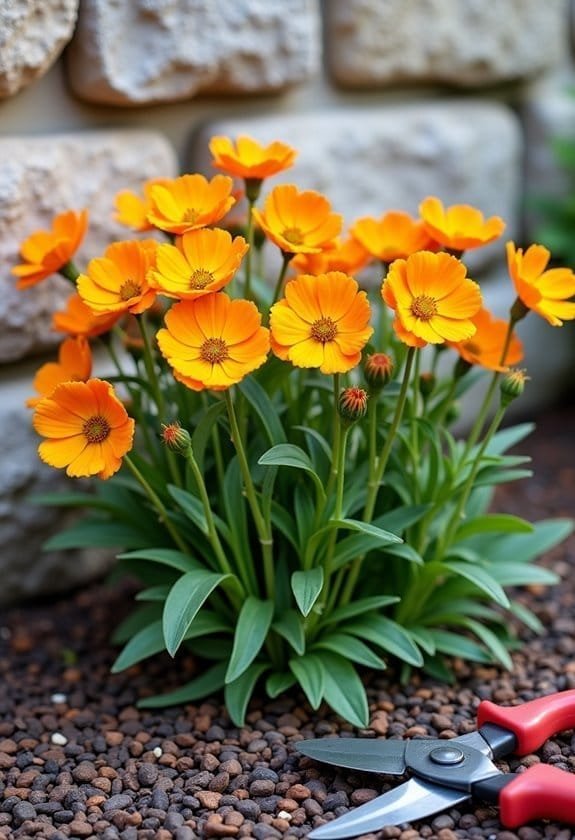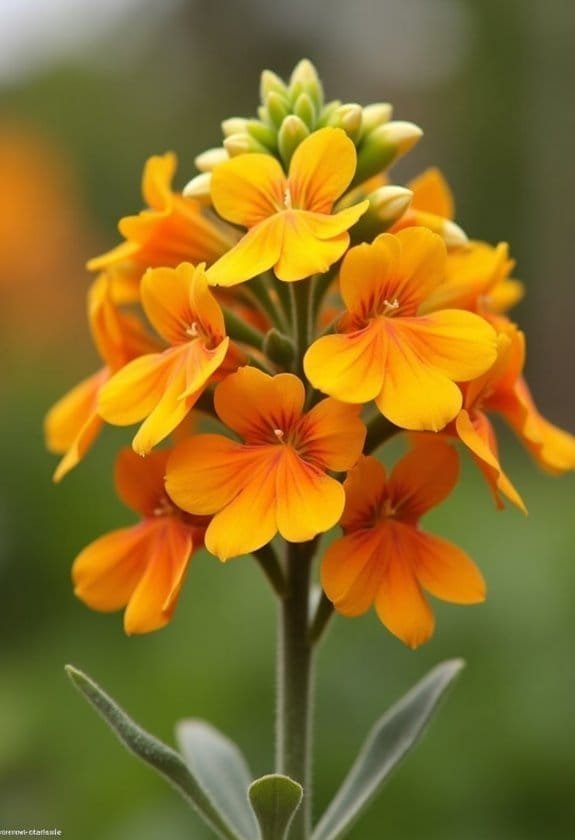Erysimum species, commonly known as wallflowers, are versatile flowering plants belonging to the Brassicaceae family. They produce distinctive four-petaled blooms in vibrant yellows, oranges, reds, and pinks, typically flowering from mid-spring through early summer. These hardy plants thrive in full sunlight and well-drained soil with pH levels between 6.0 and 7.5, making them adaptable to various garden settings. Wallflowers aren't just ornamental – they're ecological powerhouses that attract beneficial pollinators like bees and butterflies while producing bioactive compounds including glucosinolates and cardiac glycosides. Their combination of beauty and utility makes them fascinating subjects for both gardeners and researchers seeking to understand their full potential.
Main Points
- Erysimum species are flowering plants in the Brassicaceae family, known as wallflowers, featuring four-petaled blooms in yellows, oranges, reds, and pinks.
- Wallflowers bloom from mid-spring to early summer, requiring full sunlight and well-drained soil with pH between 6.0 and 7.5.
- These plants attract pollinators like bees and butterflies, contributing to ecosystem health while providing essential nectar and pollen resources.
- Common issues include aphid infestations and powdery mildew, but they can be managed with insecticidal soaps and proper growing conditions.
- Wallflowers contain bioactive compounds like glucosinolates and cardiac glycosides, historically used in traditional medicine for heart and respiratory conditions.
Introduction

Erysimum species, commonly known as wallflowers, represent a diverse genus of flowering plants within the Brassicaceae family, exhibiting distinctive cruciferous characteristics.
These resilient plants showcase an impressive range of flower colors, from vivid yellows and oranges to deep reds and pinks, making them prominent features in gardens and natural landscapes across various climatic zones.
The genus encompasses annual, biennial, and perennial varieties that have evolved specialized adaptations for different habitats, while producing bioactive compounds like glucosinolates and cardiac glycosides that serve both ecological and medicinal purposes.
Common Name
Many of these flowering plants are commonly known as wallflowers, a name that captures their tendency to grow in rocky walls and cliff faces in their native habitats. This common name has become deeply ingrained in horticultural traditions, reflecting both the plants' natural growing habits and their widespread cultivation in gardens worldwide.
The designation "wallflower" encompasses various species within the Erysimum genus, each contributing its own distinctive characteristics to this beloved group of garden plants. These adaptable flowers have earned their reputation through their ability to thrive in challenging environments, producing vibrant blooms that range from sunny yellows to deep purples.
Among the most recognized examples is Erysimum capitatum, the coastal wallflower, which demonstrates the remarkable diversity within this genus through its presence in multiple North American ecosystems.
The historical significance of these plants extends beyond their ornamental value, as suggested by their scientific name's Greek origins, which implies medicinal properties. Their ability to attract beneficial pollinators, combined with their aromatic qualities, has secured their position as both practical and aesthetically pleasing garden specimens.
Scientific Name
Within the Brassicaceae family, also known as the mustard family, the scientific name Erysimum represents a diverse genus of flowering plants that share distinctive four-petaled blooms and elongated seed pods called siliques. This taxonomic classification encompasses numerous species, each demonstrating unique adaptations to their respective environments while maintaining the core characteristics of the genus.
Among the most notable members of the Erysimum genus are E. capitatum, which has established itself as a prominent coastal wallflower throughout North America's varied landscapes, and E. cheiranthoides, whose historical significance extends into ancient medicinal practices.
The scientific nomenclature of Erysimum species reflects their evolutionary relationships and morphological features, providing researchers with a standardized system for classification and study.
The genus designation serves as a fundamental reference point for botanists and researchers working to understand the complex interactions between different Erysimum species and their ecological roles. This scientific framework has proven essential for documenting the genus's remarkable diversity and studying the adaptive strategies that have enabled these plants to thrive across various habitats.
Overview
The diverse genus of wallflowers represents a remarkable group of flowering plants that has captured the attention of botanists and gardeners alike. As members of the Brassicaceae family, these cruciferous plants exhibit distinctive characteristics that set them apart within their botanical lineage, including species like the widely distributed Erysimum cheiranthoides.
Wallflowers demonstrate impressive adaptability across various growth patterns, manifesting as annuals, biennials, or perennials depending on environmental conditions and genetic predisposition. Their presence spans numerous habitats throughout the northern hemisphere, from rocky mountain slopes to disturbed urban landscapes, where they establish themselves with notable resilience.
The genus's ecological significance extends beyond its adaptability, as these plants produce specialized chemical compounds that serve essential defensive functions. Their production of glucosinolates and cardenolides creates an effective natural barrier against herbivorous threats, while simultaneously contributing to their historical importance in traditional medicine.
Both European and Chinese healing traditions have recognized wallflowers' therapeutic potential, particularly in treating respiratory and cardiovascular conditions.
Key Features
Erysimum species display remarkable variation in size, with heights ranging from compact 12-centimeter plants to towering specimens exceeding one meter.
The plants' distinctive appearance stems from their erect stems adorned with bifid hairs, while their leaves exhibit diversity from broad and rounded to narrow and linear forms.
Their vibrant flowers, which typically emerge from late spring through mid-summer, showcase four rounded petals in hues of yellow, orange, or reddish, crowned by their characteristic elongated seed pods called siliques.
Growth Size
Among the notable characteristics of wallflowers, their growth size showcases remarkable diversity. The Erysimum species typically develop slender, upright stems that range from a diminutive 12 centimeters to an impressive height exceeding one meter, allowing these versatile plants to adapt to various garden settings and purposes.
Their growth patterns reflect the plants' lifecycle classifications, whether annual, biennial, or herbaceous perennial, with each form contributing to their adaptable nature in garden designs.
The compact structure of wallflowers, characterized by alternately arranged lance-shaped leaves along their stems, enables them to serve effectively as border edging plants while maintaining an elegant vertical presence.
Their flower clusters, densely packed at the stem tops, create striking visual displays in various hues, from vibrant yellows to deep purples, without compromising their manageable size.
The moderate growth dimensions make wallflowers particularly suited for diverse garden applications, thriving in contained spaces such as rock gardens and pots, while simultaneously holding their own in larger border arrangements.
Appearance
Distinctive visual features characterize wallflowers, starting with their bright yellow to orange blossoms that measure roughly one inch across. These Erysimum flowers display four rounded petals arranged symmetrically around six prominent stamens, creating a striking visual presence in gardens and natural settings.
The plants stand upright on slender stems that showcase a remarkable range of heights, from compact 12-centimeter varieties to towering specimens exceeding one meter. Their stems exhibit specialized malpighiaceous or dolabriform hairs, while their foliage presents an interesting contrast between broad, rounded basal leaves and narrow, lance-shaped upper leaves. The distinctive gray-green coloration results from a dense covering of minute, star-shaped hairs across the leaf surfaces.
Perhaps most notable are the plants' elongated seed pods, or siliques, which extend up to three inches in length and may curve slightly as they mature.
The flowering pattern creates eye-catching displays, with blooms clustering both at stem tips and within leaf axils, providing vibrant color throughout spring and summer months.
Flowering Season
Throughout the growing season, vibrant blossoms grace Erysimum species from mid-spring to early summer, with certain varieties extending their display into fall or winter months. The distinctive flowering patterns showcase remarkable diversity among different species, creating an extended period of garden interest that captivates both gardeners and pollinators alike.
Individual Erysimum species exhibit subtle variations in their blooming schedules, adapting to local climate conditions and genetic predispositions. Erysimum capitatum, for instance, produces its spectacular floral display from late spring through midsummer, while Erysimum walbertons fragrant sunshine reveals its blossoms slightly earlier, flowering from mid-spring to midsummer. These timing differences contribute to the genus's versatility in garden design and ecological significance.
The flowers emerge in dense clusters atop erect stems, featuring the characteristic four-petaled structure typical of the Brassicaceae family. Their vibrant palette ranges from sunny yellows and warm oranges to deep reds and sophisticated mauves, creating stunning visual displays that persist throughout their respective blooming periods.
This extended flowering season, combined with their diverse color range, makes Erysimum species particularly valuable for maintaining continuous garden interest.
Growing Requirements

Erysimum species require full sunlight exposure and well-draining soil conditions to reach their maximum flowering potential.
Ideal growth occurs in temperatures between 60-75°F (15-24°C), with these plants showing remarkable adaptability to various soil types, from sandy loam to clay-based mixtures.
While they're drought-tolerant once established, consistent moisture through regular watering and proper mulching guarantees robust growth, particularly during their active growing season when temperatures rise above 65°F (18°C).
Light
Proper sunlight exposure plays an essential role in the successful cultivation of Erysimum species. These resilient Wallflower plants require a minimum of six hours of direct sunlight daily to achieve ideal growth patterns and produce their characteristic vibrant blooms.
In regions with intense summer heat, some varieties demonstrate remarkable adaptability by tolerating partial shade conditions while maintaining healthy development.
The relationship between light exposure and flowering performance in Erysimum species is particularly significant. Plants receiving abundant sunlight typically reward gardeners with denser flower clusters and more intense color saturation, functioning as natural indicators of proper light conditions.
When light requirements aren't met, these otherwise robust plants often exhibit telltale signs of stress, including elongated, spindly growth and diminished flowering capacity.
While Erysimum species show impressive adaptability across various light conditions, consistent exposure to adequate sunlight strengthens their overall resilience and enhances their ecological value in garden settings.
This adaptive capacity makes them versatile additions to diverse landscape designs, though ideal flowering consistently correlates with maximum sun exposure within climate-appropriate parameters.
Soil
In accordance with their Mediterranean origins, successful cultivation of Erysimum species depends heavily on well-drained soil conditions with a pH range of 6.0 to 7.5.
These adaptable plants demonstrate remarkable versatility in their soil preferences, thriving in various substrates from sandy loams to rocky terrain, provided proper drainage is maintained.
The soil's composition plays an essential role in preventing root rot, a common challenge when growing Erysimum species in heavy or waterlogged conditions.
To optimize growing conditions, incorporating organic mulch around the plant's base serves multiple purposes: it helps maintain consistent soil moisture, suppresses competing weeds, and regulates soil temperature fluctuations throughout the growing season.
During extended dry periods, the soil should maintain moderate moisture levels through regular watering, though care must be taken to avoid oversaturation.
While these plants show considerable tolerance for different soil types, their Mediterranean heritage makes them particularly well-suited to slightly alkaline or neutral conditions, where they can effectively absorb essential nutrients and develop their characteristic robust flowering displays.
Water
The water requirements of wallflowers reflect their Mediterranean origins, where they've adapted to thrive with moderate moisture levels. These resilient plants demonstrate remarkable efficiency in water usage, particularly when grown in well-draining soil conditions that mirror their natural habitat.
During the establishment phase, newly planted wallflowers require consistent moisture to develop robust root systems. Gardeners should maintain even soil moisture through regular watering, being especially vigilant during the critical first growing season.
A protective layer of mulch around the plant's base serves as a natural moisture regulator, helping to preserve valuable water resources while simultaneously deterring unwanted weed growth.
Once established, Erysimum species exhibit impressive drought tolerance, though they still benefit from supplemental watering during extended dry spells. The flowering period demands particular attention to hydration, as adequate moisture levels directly influence bloom quality and duration.
While these plants appreciate regular watering, they're susceptible to root rot in waterlogged conditions, making it essential to strike a balance between sufficient moisture and proper drainage.
Temperature
Understanding temperature requirements plays a significant role in successful wallflower cultivation, with most Erysimum species thriving in daytime temperatures between 60°F to 75°F (15°C to 24°C).
These resilient plants demonstrate remarkable cold tolerance, maintaining their liveliness even when temperatures drop to 20°F (-6°C), which makes them excellent choices for early spring gardens.
While Erysimum displays impressive frost hardiness, proper temperature management becomes essential during the peak growing season.
In regions where summer temperatures soar, these adaptable plants benefit from strategic placement in areas that offer partial shade during the most intense heat of the day. This natural cooling mechanism helps prevent heat stress and guarantees the foliage remains lush and vibrant throughout the growing period.
The timing of Erysimum's blooming cycle aligns perfectly with spring's moderate temperatures, creating ideal conditions for flower development.
As daylight hours lengthen and temperatures stabilize within the plant's preferred range, these environmental cues trigger robust flowering, resulting in the spectacular display that makes wallflowers such cherished garden specimens.
Pollinator Criteria
Erysimum species showcase remarkable pollinator relationships through their vibrant yellow to orange blooms, which attract a diverse array of beneficial insects and birds.
The flowers' distinctive four-petaled structure, measuring up to one inch across, creates an ideal landing platform for bees, butterflies, and specialized pollinators like Anthophora alluadii.
During spring and summer flowering periods, these wallflowers play an essential role in supporting ecosystem health by providing necessary nectar and pollen resources that sustain pollinator populations and promote genetic diversity within plant communities.
Attracted Pollinators
Many pollinator species find themselves drawn to the vibrant and fragrant blooms of Erysimum plants, with bees, butterflies, and various insects actively seeking out these flowers during their spring to summer flowering period.
The clustered arrangement of these blossoms serves as a natural beacon, enhancing their visibility and accessibility to passing pollinators searching for nectar and pollen resources.
Among the diverse array of visitors, certain specialists have developed particularly strong associations with Erysimum flowers. The bee species Anthophora alluadii demonstrates a notable preference for these plants, establishing a mutually beneficial relationship that has evolved over time.
This specialized interaction highlights the intricate connections between plant and pollinator communities in natural ecosystems.
The successful pollination of Erysimum species depends heavily on these insect visitors, who transfer pollen between flowers while foraging.
This process plays an essential role in maintaining genetic diversity within Erysimum populations, ensuring their continued survival and adaptation to changing environmental conditions.
The timing of their flowering period strategically coincides with peak pollinator activity, maximizing reproductive success through these important interactions.
Pollination Method
The successful reproduction of Erysimum species relies on specific criteria that guide their pollination methods. These plants have evolved sophisticated mechanisms that maximize their reproductive success through strategic flower placement and attractive features. The bright clusters of inch-wide blooms, positioned prominently in the upper regions of the plant, create an efficient landing platform for visiting pollinators.
Erysimum species employ a multi-faceted approach to guarantee successful pollination, combining visual and olfactory signals that attract diverse pollinator groups. Their sweet, spicy fragrances work in concert with vibrant yellow to orange petals, creating an irresistible beacon for potential pollinators.
Some species have developed specialized relationships with particular pollinators, such as Anthophora alluadii, demonstrating the intricate co-evolution between plant and pollinator.
The pollination strategy of Erysimum contributes greatly to both agricultural productivity and ecosystem stability. Through their careful orchestration of flower placement, color, and scent, these plants maintain genetic diversity while supporting essential pollinator populations, ultimately strengthening the broader environmental network they inhabit.
Care & Maintenance

Successful cultivation of Erysimum species begins with proper planting in well-drained soil and full sun exposure, which establishes the foundation for robust growth.
The ongoing care routine integrates regular watering during dry spells, timely fertilization during active growth phases, and strategic pruning of spent blooms to maintain the plant's health and aesthetic appeal.
These wallflowers perform exceptionally well when planted alongside drought-tolerant companions such as lavender and salvias, creating a harmonious garden display while sharing similar maintenance requirements.
Planting Tips
Growing Erysimum species requires careful attention to several key maintenance practices for ideal results. These versatile plants demand specific conditions to thrive, particularly regarding their planting location and soil composition.
When selecting a planting site, gardeners should prioritize areas that receive full sun exposure, as this is vital for robust growth and abundant flowering. The soil must be well-draining to prevent root rot, which can be achieved by incorporating organic matter or gritty materials into heavy soils.
Spacing between plants should allow for adequate air circulation, typically 12-18 inches apart, depending on the variety.
For container planting, choose pots with sufficient drainage holes and use a high-quality potting mix that promotes good drainage. During the establishment phase, consistent moisture is essential, but avoid waterlogging the soil.
Adding a 2-3 inch layer of mulch around newly planted Erysimum helps maintain soil moisture and suppress weed growth, while gradually improving soil structure as it decomposes.
In regions with harsh winters, autumn planting allows roots to establish before freezing temperatures arrive.
Ongoing Care
Throughout the growing season, Erysimum species require consistent attention to maintain their health and flowering potential. These herbaceous perennials thrive when provided with regular watering during dry spells, guaranteeing their root systems remain adequately hydrated for peak growth and bloom production.
The ongoing care of wallflowers encompasses several crucial maintenance tasks that gardeners must perform throughout the growing cycle. During active growth periods, applying a balanced fertilizer strengthens the plants' vigor and enhances their flowering capacity.
After the primary blooming phase, strategic pruning not only maintains the desired shape but can also stimulate a second flush of flowers in certain varieties. Environmental protection plays an essential role in wallflower cultivation, with mulch application serving as an effective moisture retention strategy while simultaneously suppressing competitive weed growth.
Vigilant monitoring for common pests becomes critical, as early detection and prompt management of infestations can prevent significant damage to both foliage and blooms. These care practices, when implemented consistently, guarantee that Erysimum species maintain their characteristic vibrancy and continue to enhance garden displays throughout their growing season.
Suggested Companions
Selecting compatible companion plants for Erysimum species proves vital for creating a thriving garden environment. Drought-tolerant plants like lavender and sedum make excellent neighbors, as they share similar cultural requirements for water and sunlight exposure. These combinations create visually striking displays while maintaining ecological harmony in the garden bed.
When planning companion arrangements, proper spacing becomes essential for ideal growth. Erysimum's upright stems require adequate air circulation and light exposure, which can be achieved by thoughtfully positioning neighboring plants. Complementary species like salvia and echinacea extend the garden's visual appeal beyond the wallflower's blooming period, creating sustained seasonal interest.
Strategic mulching around Erysimum and its companion plants helps maintain consistent soil moisture levels while suppressing unwanted weed growth.
The integration of aromatic herbs, particularly thyme and rosemary, serves multiple purposes in the garden ecosystem. These herbs not only enhance the overall pest resistance of the planting area but also attract beneficial insects that support pollination and natural pest control mechanisms.
Common Issues
Erysimum species face several notable challenges, with aphid infestations and powdery mildew being particularly problematic for these ornamental plants.
Gardeners must remain vigilant for signs of these issues, as aphids can quickly colonize new growth, while the telltale white coating of powdery mildew often appears during periods of high humidity.
Regular inspection and preventive measures, including proper plant spacing and careful watering practices, can help minimize the impact of these common problems and maintain the plant's health throughout its growing season.
Pests/Diseases
Like many ornamental plants, wallflowers face several common pest and disease challenges that can impact their health and appearance. Among the most troublesome pests are aphids, which actively weaken plants by extracting essential sap from stems and leaves while potentially serving as vectors for various plant diseases.
Additionally, cabbage loopers and diamondback moth larvae can greatly compromise plant vigor through their voracious feeding habits on wallflower foliage.
Disease management presents another critical concern for wallflower cultivation, with powdery mildew emerging as a particularly persistent threat. This fungal infection manifests as characteristic white, powder-like spots across leaves and stems, flourishing especially in humid environments that promote spore development.
Root rot poses an equally serious challenge, typically resulting from excessive moisture retention in poorly draining soils, leading to systemic plant decline evidenced by wilting and leaf discoloration.
Fortunately, gardeners can implement effective control measures through vigilant monitoring, the introduction of beneficial predatory insects, and the strategic application of organic fungicides, particularly when addressing fungal infections in their early stages.
Solutions
While pest and disease challenges can be intimidating, most common issues affecting Erysimum species have straightforward solutions. Proper cultural practices form the foundation of effective wallflower care, starting with appropriate spacing during planting to guarantee adequate air circulation between specimens.
For pest management, natural predators and insecticidal soap applications can effectively control aphid and caterpillar populations without compromising the plant's health. Regular monitoring allows gardeners to catch infestations early, making treatment more successful.
When it comes to maintaining vigor, implementing a consistent deadheading routine removes spent blooms and redirects the plant's energy toward producing new flowers rather than seeds. Additionally, applying a 2-3 inch layer of organic mulch around wallflower bases serves multiple purposes: it helps maintain consistent soil moisture, suppresses competing weeds, and provides essential temperature regulation for root systems.
During dry spells, supplemental watering becomes essential, but it's important to verify the soil drains well to prevent root rot, which can be devastating to these otherwise hardy plants.
Summary

This versatile genus of flowering plants encompasses numerous species that serve both ecological and medicinal purposes. Erysimum species, commonly known as wallflowers, have established themselves as remarkable contributors to both natural ecosystems and human applications throughout history.
These plants showcase an impressive array of adaptations, from their vibrant four-petaled flowers that attract diverse pollinators to their sophisticated chemical defense systems featuring glucosinolates and cardiac glycosides. Their blooming period, typically spanning spring and summer months, creates an essential resource for numerous pollinator species, contributing considerably to local biodiversity.
The genus's importance extends beyond its ecological role, as evidenced by its documented use in traditional medicine for treating various conditions, particularly heart-related ailments and respiratory issues. Modern research continues to explore the potential applications of the 48-plus species containing bioactive compounds.
The adaptability of Erysimum species, demonstrated through their various life cycles as annuals, biennials, and perennials, further underscores their significance in both natural habitats and cultivated settings.


